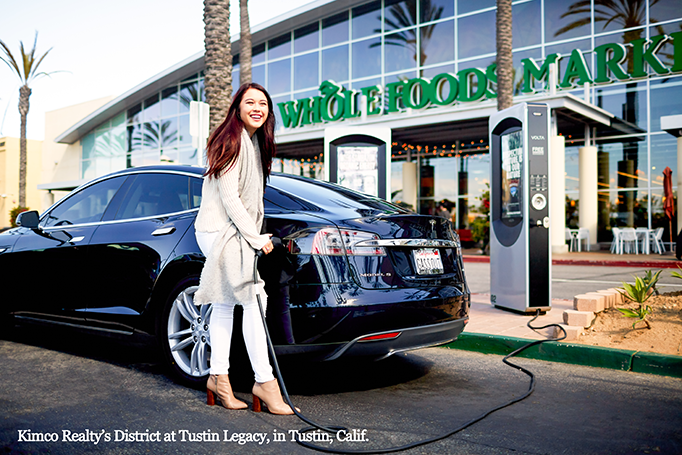
Need to pause on the trip and recharge that Tesla Model S sports car? Since nothing could be better than to add in a bit of shopping in the meantime, some retailers and shopping center owners now offer electric-vehicle charging stations so that drivers can shop while they top off those car batteries.
Tanger Factory Outlet Centers included free EV charging as part of several alternative-energy promotions it launched last July. “Nationwide, the electric-vehicle charging network system is available at 23 Tanger outlet centers in the U.S.,” said Betty Coleman, the company’s vice president of operations. “We anticipate increasing demand from -shoppers who own electric vehicles.” Tanger worked with ChargePoint, a Campbell, Calif., company that sells vehicle chargers, to offer recharging stations that the equipment provider maintains. In addition to making and selling the equipment, the company collects a license fee for inclusion in an online network of recharging locations, which helps drivers decide where to recharge. As for Tanger, its website identifies those of its outlet locations that offer charging services.
Simon may have one of the largest charging networks among retail landlords, having installed nearly 360 electric-vehicle charge stations at roughly 90 of its U.S. properties. “While drivers charge their cars, they can also take advantage of the shopping and dining options offered at our centers, so everyone benefits,” said Maria Weber, Simon’s director of corporate communications.
Macerich has introduced EV charging at 17 of its shopping centers, with an additional 15 properties to be added to the program this year. “We still have room to grow, but we’ve accomplished very good coverage across our portfolio,” said
Jeffrey Bedell, Macerich’s vice president of sustainability. “In 2015 we had over 23,000 charging sessions at those sites, so that is significant use.” Bedell says he is unconvinced that vehicle charging brings in any additional business, reasoning that most customers using these stations were probably coming to the shopping center anyway. But that, he insists, is beside the point, because Macerich sees a growing need for the service and is answering that call. “We really do it as an amenity for our guests and for our communities,” Bedell said. “It’s a nice enhancement, and there’s just not much of a downside to doing it.”
The companies that make and install charging equipment are often the best judges of whether a retail property is a good candidate for a charging station, Bedell says, because those stations are more plugged into municipal and regional designs intended to blanket geographic areas with well-spaced, publicly accessible charging. “We tend to work with the providers to define those properties and those markets that are best suited,” Bedell said. “The last thing we want to do is put chargers in and have them sit there unused.” Macerich has worked with various equipment providers to set up and run its EV stations and negotiated for the providers to carry the cost of installation and operation, Bedell says. The providers either charge customers a small fee for fast powering (a typical rate in many states is 50 to 60 cents per kilowatt-hour, according to online sources) or generate revenue through advertising that is akin to the video marketing at gasoline pumps.
There are some 45,000 public and private charging stations in North America now, and there are roughly twice that number in the Asia-Pacific region, according to Navigant Consulting, a global firm that tracks the energy sector. Europe has nearly 70,000 charging stations, the firm says.
The U.S. Department of Energy identifies nearly 33,000 plug-in outlets at some 13,000 public charging stations in the U.S. alone. Roughly 60 percent of those U.S. locations offer electricity free of charge to the driver, according to Scott Mercer, founder and CEO of San Francisco–based Volta Charging. The company provides turnkey setups for property owners through one or more parking spaces and profits from the sale of advertising projected onto flat-screen video monitors at its stations. “From what we’ve seen, charging itself is not a revenue center,” Mercer said. “Generally, property owners install the stations as a loss leader to bring people in.” For a full charge, cars will use up anywhere from three to 10 kilowatt-hours, and power requirements will vary. “Our average utility bill is a couple hundred dollars a month,” said Mercer.
Some landlords do charge fees for the service, according to Tony Canova, COO of ChargePoint. “There are some major malls that have successfully demonstrated that they can charge money and still attract people to the store,” Canova said. “But remember that one of the reasons people buy electric vehicles is because [they are] very inexpensive to drive. If you charge too much for energy, you will anger an EV driver — it’s almost an insult.” ChargePoint’s equipment costs between $3,000 and $3,500 per parking space, and a typical installation costs an additional $2,000 to $3,000. “Of course, it’s much cheaper in new construction, because running power is the majority of the installation,” Canova said. For that reason, ChargePoint recommends that developers extend electrical service to between 5 and 10 percent of parking spaces in lots under construction, even if they have no immediate plans to install chargers.
“The developer of any new mall being built in a geographic area where there are, or are expected to be, a high concentration of EVs should be thinking about installing charging stations,” Canova said. “At a minimum, they should be wiring spots so they can put in charging stations later.”
